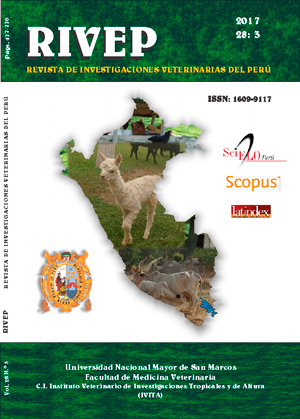Myocardial tissue damage in ovariectomized mice and experimentally infected with Trypanosoma cruzi
DOI:
https://doi.org/10.15381/rivep.v28i3.13352Keywords:
Chagas disease, Trypanosoma cruzi strains, ovariectomy, histopathological study, inflammatory infiltrate, tissue damageAbstract
This study aimed to evaluate the damage in the myocardial tissue in ovariectomized and non-ovariectomized Balb/c mice and the relationship with inflammatory damage, number of pseudocysts and correlation with parasitemia levels and mortality after experimental infection with 2000 blood trypomastigotes from clone Dm28c of Trypanosoma cruzi. Results showed a 3-day blood prepatency and higher parasitemia levels (p<0.001) during the first 9 days of infection (p.i.) in ovariectomized females when compared with non-ovariectomized females which showed a 5-day prepatency. However, the maximum parasitemia level reached by the ovariectomized females (18.09 x 104 ± 1.66 x 104 parasites/ml) at 11 days p.i. was lower (p<0.05) than the maximum parasitemia level of 26.03 x 104 ± 1.83 x 104 parasites/ml, observed in the non-ovariectomized females at 11 days p.i. The histopathological analysis showed a correlation between the high number of intracellular parasites (pseudocysts), the magnitude of mononuclear inflammatory infiltrate, the severity of cardiac tissue damage and the 100% mortality reached by the ovariectomized females at 21 days p.i. in comparison with the lower values and the 70% mortality showed by the non-ovariectomized females in the same period. Sexual-based differences in susceptibility or resistance to infection should not be overlooked as an additional variable but as an important risk factor in the development of infectious diseases.Downloads
Downloads
Published
Issue
Section
License
Copyright (c) 2017 Julio Larenas Herrera, Belén Bello González, Claudio Zúñiga Marti, María Teresa Paláu Castaño, Ulises Vergara Castillo

This work is licensed under a Creative Commons Attribution-NonCommercial-ShareAlike 4.0 International License.
AUTHORS RETAIN THEIR RIGHTS:
a. Authors retain their trade mark rights and patent, and also on any process or procedure described in the article.
b. Authors retain their right to share, copy, distribute, perform and publicly communicate their article (eg, to place their article in an institutional repository or publish it in a book), with an acknowledgment of its initial publication in the Revista de Investigaciones Veterinarias del Perú (RIVEP).
c. Authors retain theirs right to make a subsequent publication of their work, to use the article or any part thereof (eg a compilation of his papers, lecture notes, thesis, or a book), always indicating the source of publication (the originator of the work, journal, volume, number and date).










